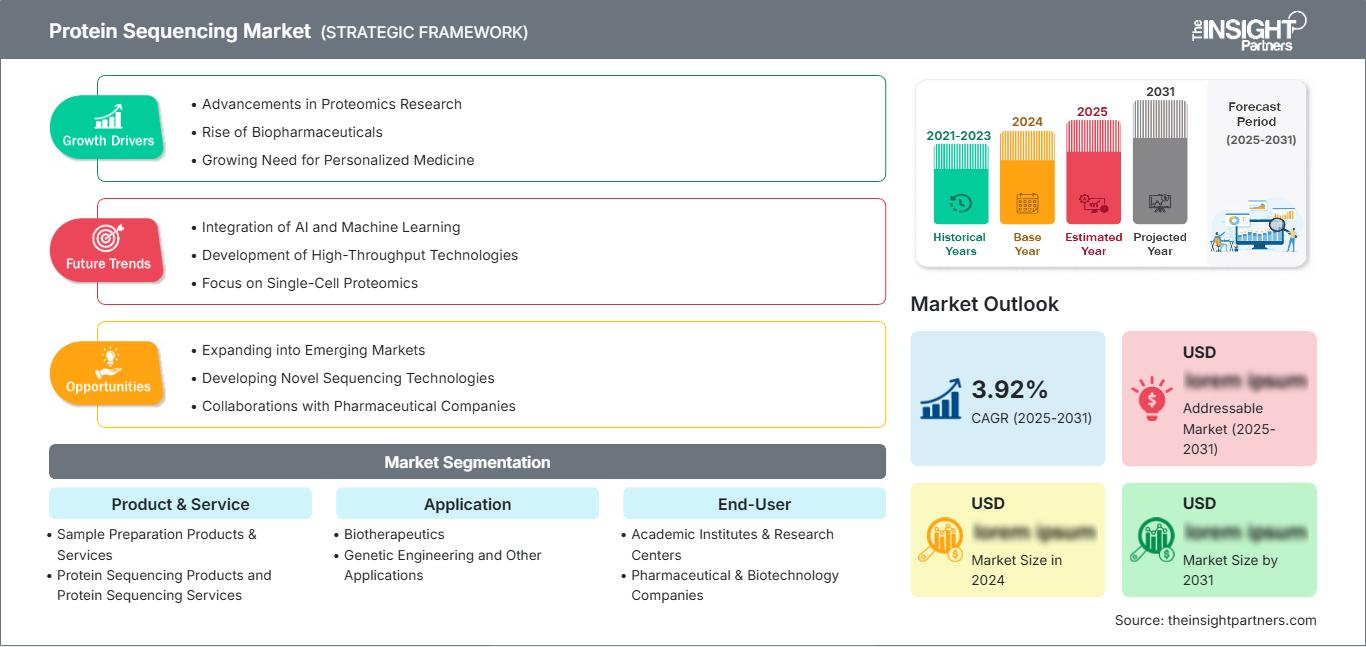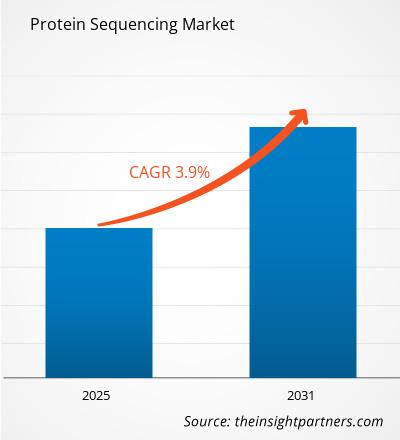Si prevede che il mercato del sequenziamento proteico registrerà un CAGR del 3,92% dal 2025 al 2031, con una dimensione del mercato in espansione da XX milioni di dollari nel 2024 a XX milioni di dollari entro il 2031.
Il rapporto è suddiviso in quattro sezioni: Prodotti e servizi (Prodotti e servizi per la preparazione dei campioni, Prodotti e servizi per il sequenziamento proteico), Applicazioni (Bioterapeutici, Ingegneria genetica e altre applicazioni) e Utenti finali (Istituti accademici e centri di ricerca, aziende farmaceutiche e biotecnologiche). L'analisi globale è suddivisa a livello regionale e per i principali paesi. La valutazione del mercato è presentata in dollari USA per l'analisi segmentale di cui sopra.
Scopo del rapporto
Il rapporto "Protein Sequencing Market" di The Insight Partners mira a descrivere il panorama attuale e la crescita futura, i principali fattori trainanti, le sfide e le opportunità. Ciò fornirà spunti a vari stakeholder aziendali, come:
- Fornitori/produttori di tecnologia: per comprendere le dinamiche di mercato in evoluzione e conoscere le potenziali opportunità di crescita, consentendo loro di prendere decisioni strategiche informate.
- Investitori: per condurre un'analisi completa delle tendenze in merito al tasso di crescita del mercato, alle proiezioni finanziarie del mercato e alle opportunità esistenti lungo la catena del valore.
- Organismi di regolamentazione: per regolamentare le politiche e le attività di controllo nel mercato con l'obiettivo di ridurre al minimo gli abusi, preservare la fiducia degli investitori e sostenere l'integrità e la stabilità del mercato.
Prodotti e servizi per la segmentazione del mercato del sequenziamento proteico
- Prodotti e servizi per la preparazione dei campioni
- Prodotti e servizi per il sequenziamento proteico
Applicazione
- Bioterapeutici
- Ingegneria genetica e altre applicazioni
Utente finale
- Istituti accademici e centri di ricerca
- Aziende farmaceutiche e biotecnologiche
Geografia
- Nord America
- Europa
- Asia-Pacifico
- America meridionale e centrale
- Medio Oriente e Africa
Potrai personalizzare gratuitamente qualsiasi rapporto, comprese parti di questo rapporto, o analisi a livello di paese, pacchetto dati Excel, oltre a usufruire di grandi offerte e sconti per start-up e università
Mercato del sequenziamento delle proteine: Approfondimenti strategici

-
Ottieni le principali tendenze chiave del mercato di questo rapporto.Questo campione GRATUITO includerà l'analisi dei dati, che vanno dalle tendenze di mercato alle stime e alle previsioni.
Fattori di crescita del mercato del sequenziamento proteico
- Progressi nella ricerca proteomica: i continui progressi nella ricerca proteomica, tra cui tecniche come la spettrometria di massa e la cromatografia, stanno alimentando la domanda di un sequenziamento proteico accurato ed efficiente.
- Ascesa dei prodotti biofarmaceutici: il fiorente settore biofarmaceutico fa molto affidamento sul sequenziamento proteico per la scoperta di farmaci, lo sviluppo e il controllo di qualità dei prodotti bioterapici.
- Crescente necessità di medicina personalizzata: la crescente attenzione alla medicina personalizzata richiede una comprensione più approfondita dei singoli proteomi, determinando la necessità di tecnologie di sequenziamento proteico accurate e sensibili.
Tendenze future del mercato del sequenziamento proteico
- Integrazione di intelligenza artificiale e apprendimento automatico: gli algoritmi di intelligenza artificiale e apprendimento automatico vengono sempre più utilizzati per analizzare dati complessi di sequenziamento proteico, migliorare l'interpretazione dei dati e accelerare la scoperta di nuovi biomarcatori proteici.
- Sviluppo di tecnologie ad alta produttività: lo sviluppo di tecnologie di sequenziamento proteico ad alta produttività è fondamentale per soddisfare la crescente domanda di analisi rapide ed economiche di grandi set di dati.
- Focus sulla proteomica a singola cellula: la proteomica a singola cellula è un campo emergente che mira ad analizzare l'espressione proteica a livello di singola cellula, fornendo preziose informazioni sull'eterogeneità cellulare e sui meccanismi delle malattie.
Opportunità di mercato per il sequenziamento delle proteine
- Espansione nei mercati emergenti: esplorazione di mercati inesplorati nelle economie in via di sviluppo, dove gli investimenti nella ricerca in ambito sanitario e delle scienze della vita sono in aumento.
- Sviluppo di nuove tecnologie di sequenziamento: investimenti nella ricerca e nello sviluppo di nuove tecnologie di sequenziamento delle proteine, come il sequenziamento a nanopori e la microscopia a super risoluzione, per migliorare sensibilità, accuratezza e produttività.
- Collaborazioni con aziende farmaceutiche: collaborazione con aziende farmaceutiche e biotecnologiche per lo sviluppo congiunto e la commercializzazione di tecnologie innovative di sequenziamento delle proteine per la scoperta e lo sviluppo di farmaci.
Approfondimenti regionali sul mercato del sequenziamento delle proteine
Le tendenze regionali e i fattori che influenzano il mercato del sequenziamento proteico durante il periodo di previsione sono stati ampiamente spiegati dagli analisti di The Insight Partners. Questa sezione illustra anche i segmenti e la geografia del mercato del sequenziamento proteico in Nord America, Europa, Asia-Pacifico, Medio Oriente e Africa, America meridionale e centrale.
Ambito del rapporto di mercato sul sequenziamento delle proteine
| Attributo del rapporto | Dettagli |
|---|---|
| Dimensioni del mercato in 2024 | US$ XX million |
| Dimensioni del mercato per 2031 | US$ XX Million |
| CAGR globale (2025 - 2031) | 3.92% |
| Dati storici | 2021-2023 |
| Periodo di previsione | 2025-2031 |
| Segmenti coperti |
By Prodotti e servizi
|
| Regioni e paesi coperti |
Nord America
|
| Leader di mercato e profili aziendali chiave |
|
Densità degli operatori del mercato del sequenziamento proteico: comprendere il suo impatto sulle dinamiche aziendali
Il mercato del sequenziamento proteico è in rapida crescita, trainato dalla crescente domanda degli utenti finali, dovuta a fattori quali l'evoluzione delle preferenze dei consumatori, i progressi tecnologici e una maggiore consapevolezza dei benefici del prodotto. Con l'aumento della domanda, le aziende stanno ampliando la propria offerta, innovando per soddisfare le esigenze dei consumatori e sfruttando le tendenze emergenti, alimentando ulteriormente la crescita del mercato.

- Ottieni il Mercato del sequenziamento delle proteine Panoramica dei principali attori chiave
Punti di forza
- Copertura completa: il rapporto copre in modo completo l'analisi di prodotti, servizi, tipologie e utenti finali del mercato del sequenziamento proteico, fornendo un panorama olistico.
- Analisi degli esperti: il rapporto è compilato sulla base della conoscenza approfondita di esperti e analisti del settore.
- Informazioni aggiornate: il rapporto garantisce rilevanza aziendale grazie alla sua copertura di informazioni recenti e tendenze dei dati.
- Opzioni di personalizzazione: questo rapporto può essere personalizzato per soddisfare le esigenze specifiche del cliente e adattarsi in modo appropriato alle strategie aziendali.
Il rapporto di ricerca sul mercato del sequenziamento proteico può, quindi, aiutare a guidare il percorso di decodificazione e comprensione dello scenario del settore e delle prospettive di crescita. Sebbene possano esserci alcune preoccupazioni valide, i vantaggi complessivi di questo rapporto tendono a superare gli svantaggi.
- Analisi storica (2 anni), anno base, previsione (7 anni) con CAGR
- Analisi PEST e SWOT
- Valore/volume delle dimensioni del mercato - Globale, Regionale, Nazionale
- Industria e panorama competitivo
- Set di dati Excel
Report recenti
Testimonianze
Motivo dell'acquisto
- Processo decisionale informato
- Comprensione delle dinamiche di mercato
- Analisi competitiva
- Analisi dei clienti
- Previsioni di mercato
- Mitigazione del rischio
- Pianificazione strategica
- Giustificazione degli investimenti
- Identificazione dei mercati emergenti
- Miglioramento delle strategie di marketing
- Aumento dell'efficienza operativa
- Allineamento alle tendenze normative






















 Ottieni un campione gratuito per - Mercato del sequenziamento delle proteine
Ottieni un campione gratuito per - Mercato del sequenziamento delle proteine